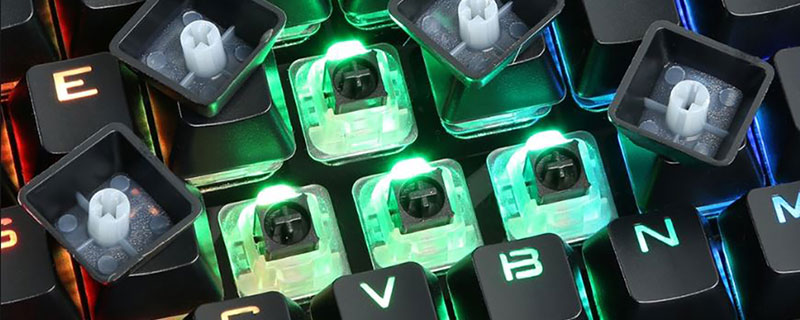
Not long ago, maybe two years back, I saw an advertisement for a mechanical keyboard. At the time I was still using a Logitech K740, a (slim) membrane keyboard that served me well and which I liked—or so I thought.
But because I’m a hardware freak who likes to try out new things I gave it a shot. I went with a custom-made—and not inexpensive—model under the WASD brand. In hindsight, I don’t regret changing my input device for typing/gaming (and I’ve already bought another mechanical keyboard, and will relegate the WASD one to a back-up role. Here’s why I like this type of keyboard.
Theory
Let’s present some theory first.
Membrane keyboards
The first layer is called the top membrane layer, with a conductive trace placed below it. When the key is pressed, it moves through the second layer, which is made up of holes, allowing the pressure pads located under each key to pass through and make contact with the conductive traces on the top of the bottom membrane layer.
Mechanical keyboards
Mechanical keyboards use switches to send the typing signal. Each key has its own switch, which comes with a base, a spring, and a stem. There are many types of switches, each of which performs differently. The most common types are blue, red, brown, and black switches. There are also different brands, like Cherry, KBT, Kailh, Outemu and Greetech, to name a few. Some require more force to press, while others are less resistant. The key action can be tactile, meaning there is a clicking sensation (and possibly a sound) when the key is pressed, or linear – offering no feedback or sound. The keycaps in mechanical keyboards are usually exchangeable, enabling users to customize their device.
Reasons to switch to a mechanical keyboard
Ok, here are the reasons I think mechanical keyboards are better than membrane ones:
Matching different typing styles
There are many different types of switches, so you can quite easily find the most comfortable one for you. This can ultimately give you just the typing rhythm you’re after, something I’d never been able to get on a membrane keyboard. It also helps avoid unintended key presses. You don’t have to press a key all the way down to the bottom for the action to register. It’s enough to do it half way and stop, which means faster typing and less fatigue.
Mechanical switches can be classified as below (based on the most popular Cherry MX switches):
- Linear
- Cherry MX Black
- Cherry MX Linear Grey
- Cherry MX Nature White
- Cherry MX Red
- Cherry MX Speed Silver
- Tactile, non-clicky
- Cherry MX Brown
- Cherry MX Clear
- Cherry MX Tactile Grey
- Tactile and clicky
- Cherry MX Blue
- Cherry MX Green
- Cherry MX White
Other manufacturers make similar switches, and they even use the same colour scheme. Brown switches are the most universal type. They’re stellar for typing, and gaming too. Many users will likely prefer RED switches if they are interested strictly in gaming, whereas blue ones will appeal to those who type a lot.
Durability
At the risk of stating the obvious, there is no membrane inside a mechanical keyboard. The MTBF for switches is a whopping 50 million strokes, and they should sing along throughout their entire lifespan just as they did on day one, with no changes in feedback. That’s a huge plus over membrane products, which usually don’t last very long (it’s currently hard to find one that will last more than 2 or 3 years). So, while mechanical keyboards are more expensive up front, their longevity may make them some friends among the frugal.
Weight
This can be a drawback for some people. Mechanical keyboards are relatively heavy, so it’s more difficult to move the input device around your desk. More weight does mean greater stability, which appeals to some. This is, of course, a simplification.
Anti-Ghosting
Most mechanical keyboards allow you to press more keys simultaneously than you could with a membrane keyboard, and some of them even have the so-called Full N-Key Rollover feature (you can press all the keys at once, and they will all register). This is particularly useful in gaming.
Removable
All the keycaps on mechanical keyboards can be removed, so cleaning them a is a cinch. Of course, you can also customize the keyboard to match the theme of your desktop or case. The caps are available in different materials as well. The cheaper sets are usually made of ABS, while thicker PBT caps are more expensive but much more durable, and resistant to the eventual “shine” effect that you get with cheaper materials.
Still, is it worth the investment?
Yes, mechanical keyboards (especially really good ones) are pricey, but you can treat a good keyboard as an investment. It’s important to have switches that respond exactly as you’d like, to provide comfort during long gaming or typing sessions. Fortunately, it’s relatively easy to choose the best switches to match your needs. The greatest strength of mechanical keyboards is how it feels to type on them – and with key travel and response more tactile than in membrane keyboards, it generally feels pretty good.
You have to remember that mechanical keyboards are not the quietest, but there are MX Silent switches, and you can always use o-rings (made of soft rubber) that can be installed on all the keycap stems to cushion the landing of the switch by stopping the key-stroke just short of the point where it bottoms out. This also ever so slightly reduces the switch’s max travel distance (0.2-0.4mm of the overall 4mm travel distance, depending on the type of O-ring). Finally, there’s this: the reduced travel distance can—can, mind you, not necessarily will—boost your game-play performance. If you have the money, this fact alone may justify splashing out some. Of course, it would be best to take a test drive at an outlet/shop before you put your money down, but that’s obvious, isn’t it?
Yes, mechanical keyboards (especially really good ones) are pricey, but you can treat a good keyboard as an investment. It’s important to have switches that respond exactly as you’d like, to provide comfort during long gaming or typing sessions. Fortunately, it’s relatively easy to choose the best switches to match your needs. The greatest strength of mechanical keyboards is how it feels to type on them – and with key travel and response more tactile than in membrane keyboards, it generally feels pretty good.
You have to remember that mechanical keyboards are not the quietest, but there are MX Silent switches, and you can always use o-rings (made of soft rubber) that can be installed on all the keycap stems to cushion the landing of the switch by stopping the key-stroke just short of the point where it bottoms out. This also ever so slightly reduces the switch’s max travel distance (0.2-0.4mm of the overall 4mm travel distance, depending on the type of O-ring). Finally, there’s this: the reduced travel distance can—can, mind you, not necessarily will—boost your game-play performance. If you have the money, this fact alone may justify splashing out some. Of course, it would be best to take a test drive at an outlet/shop before you put your money down, but that’s obvious, isn’t it?


























